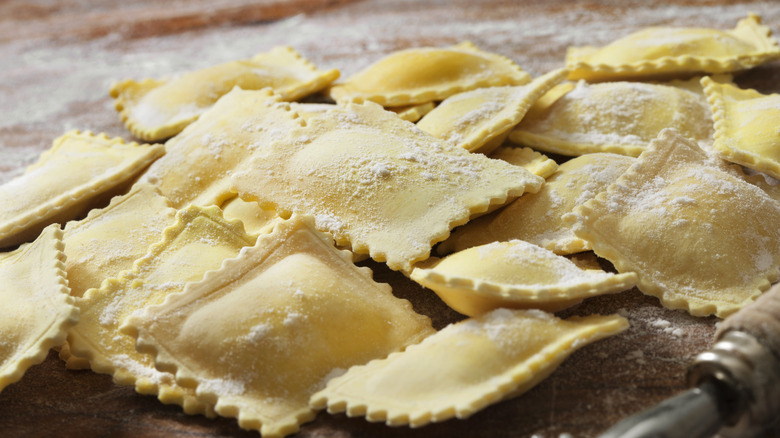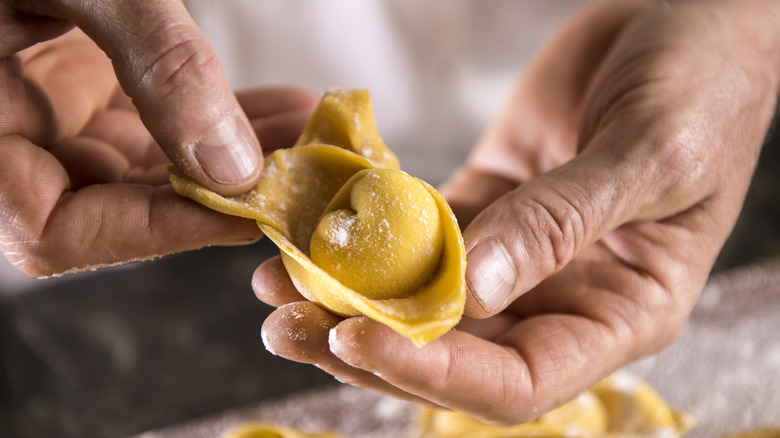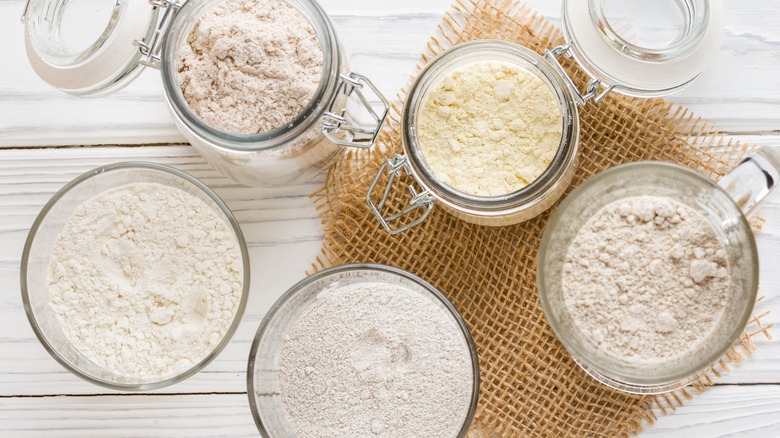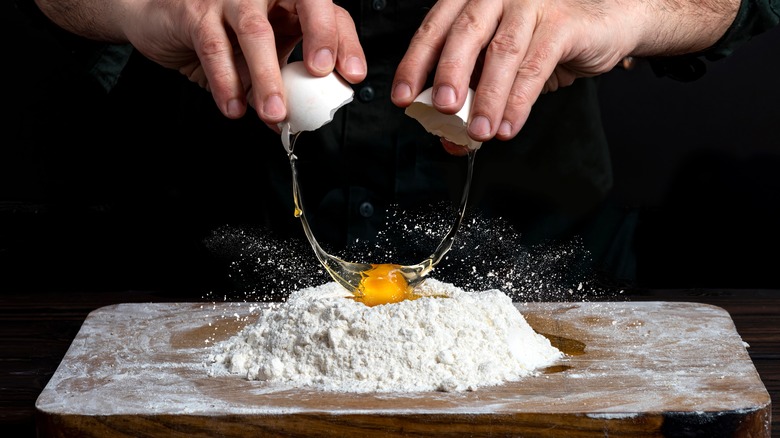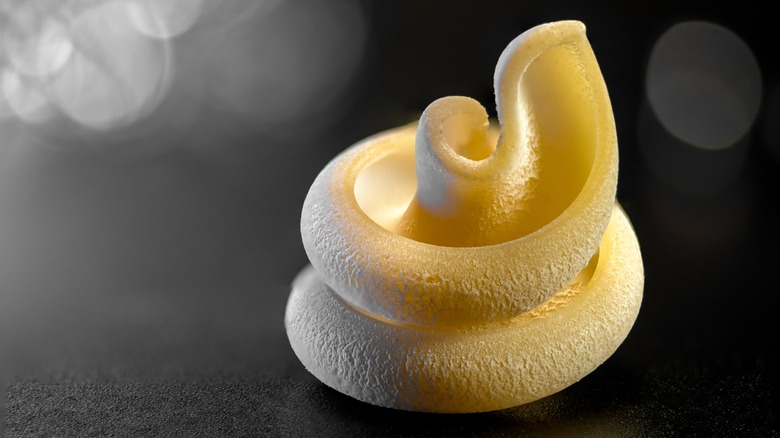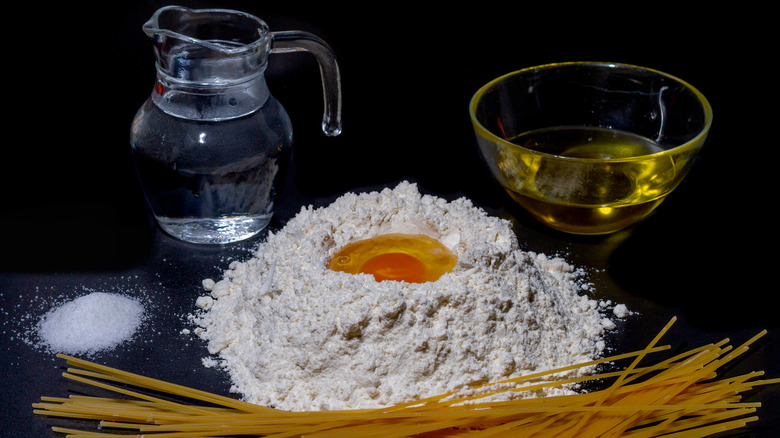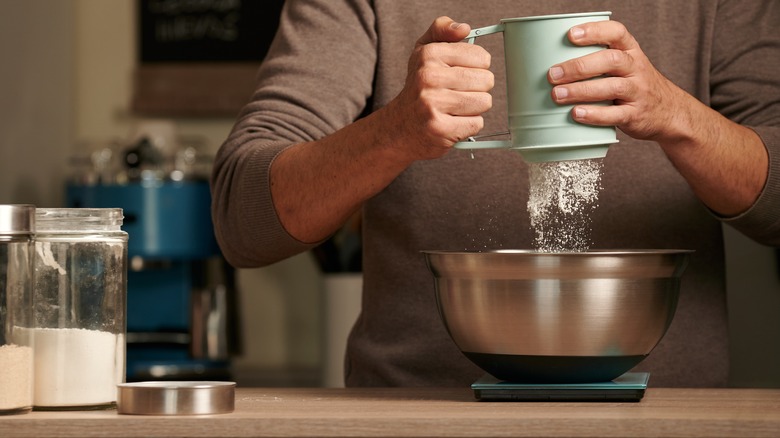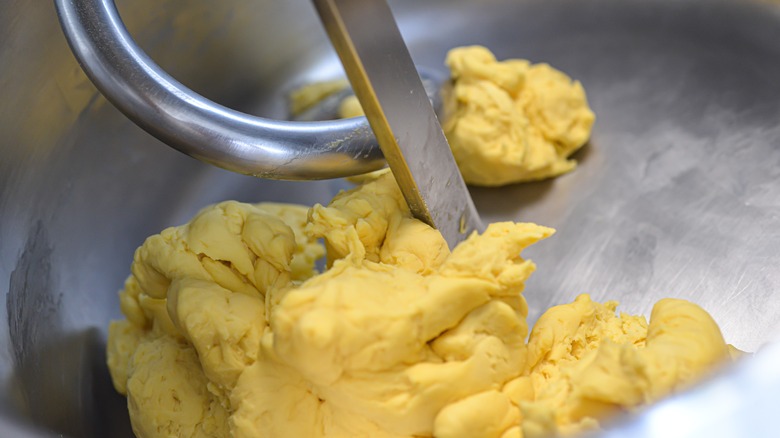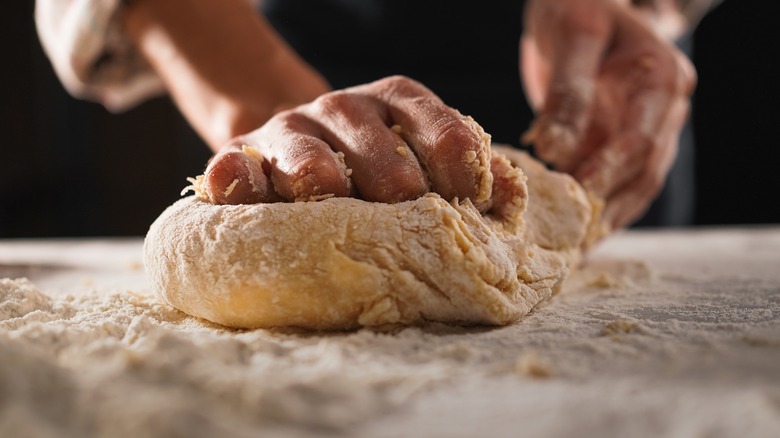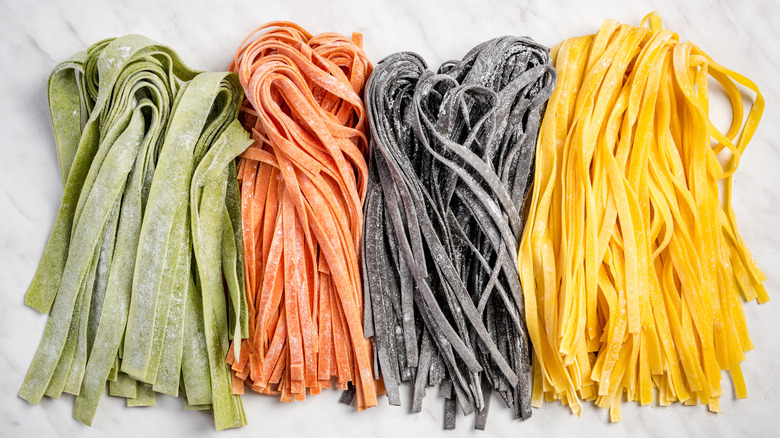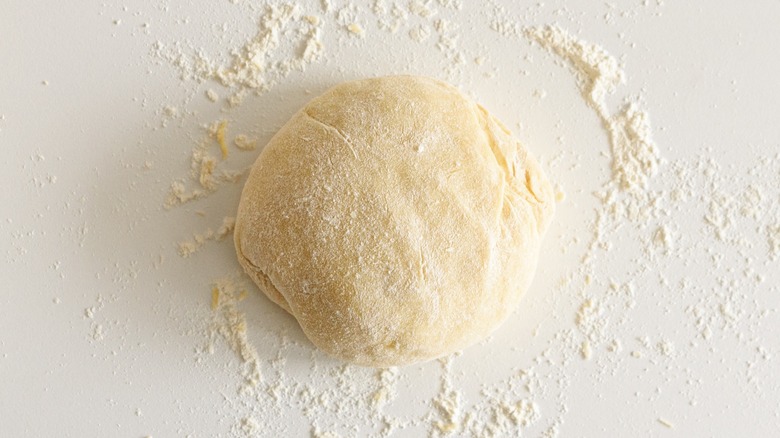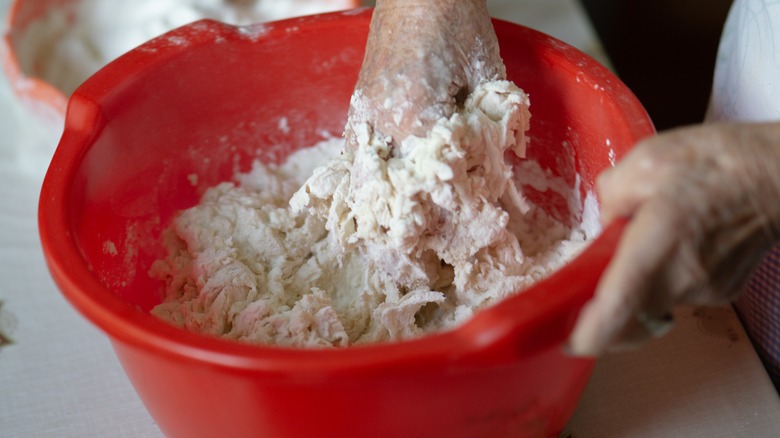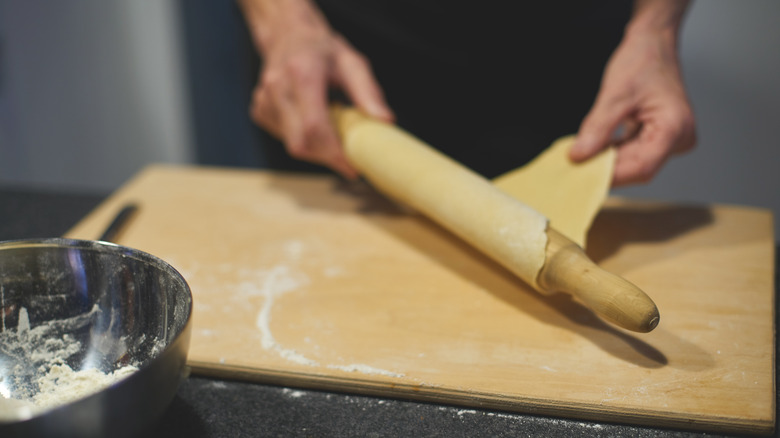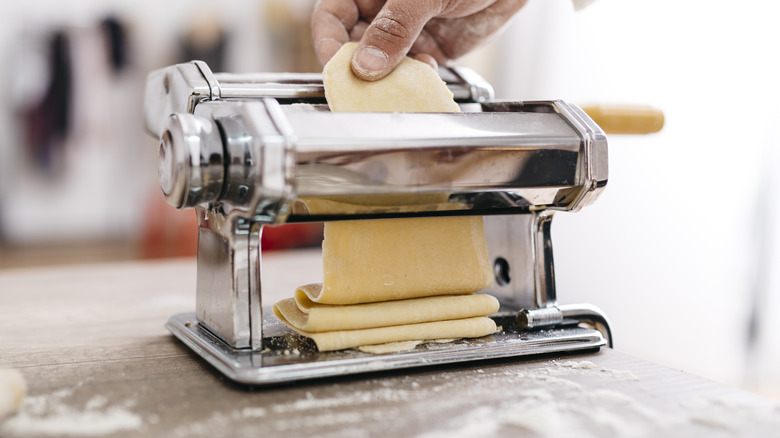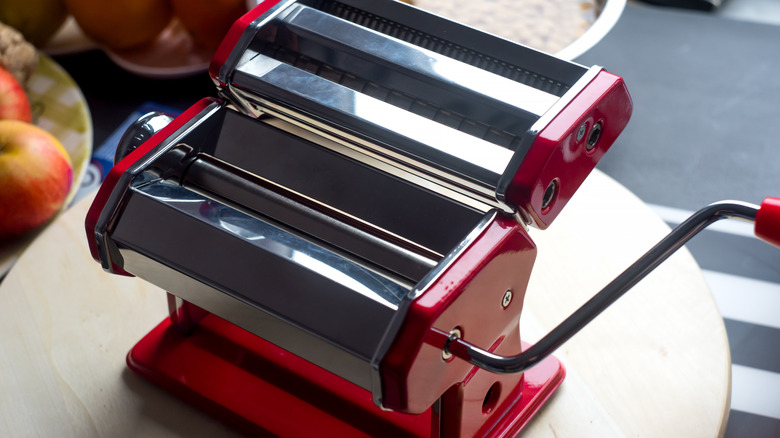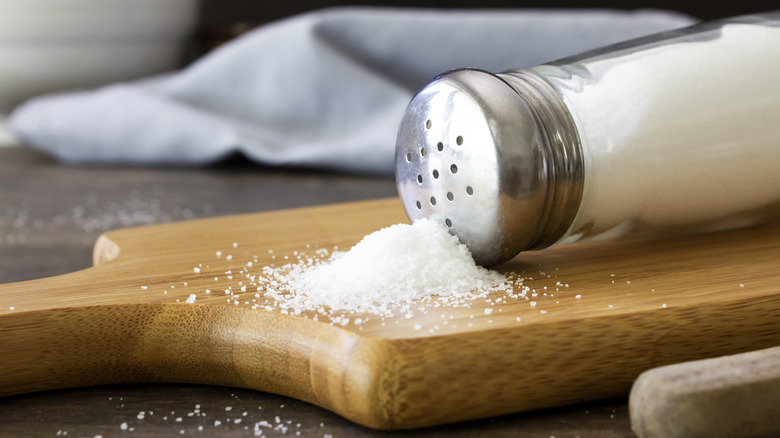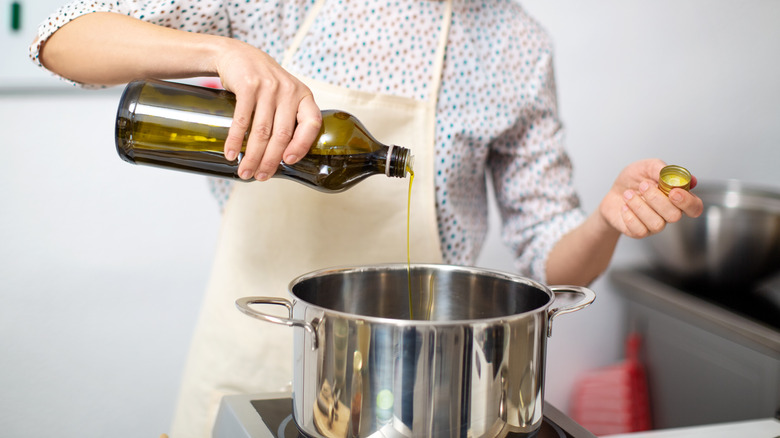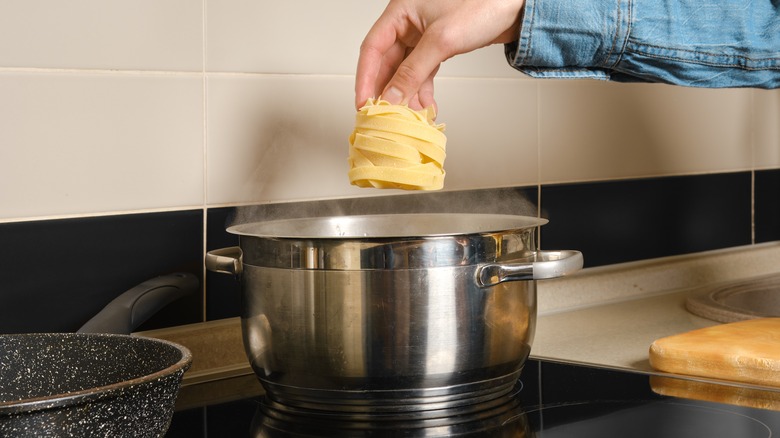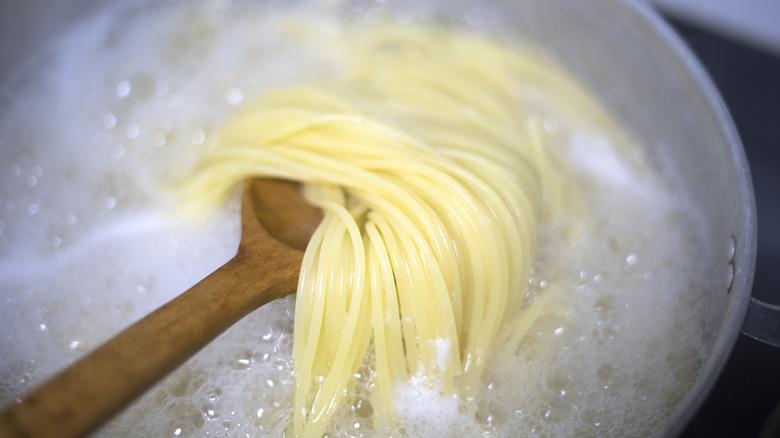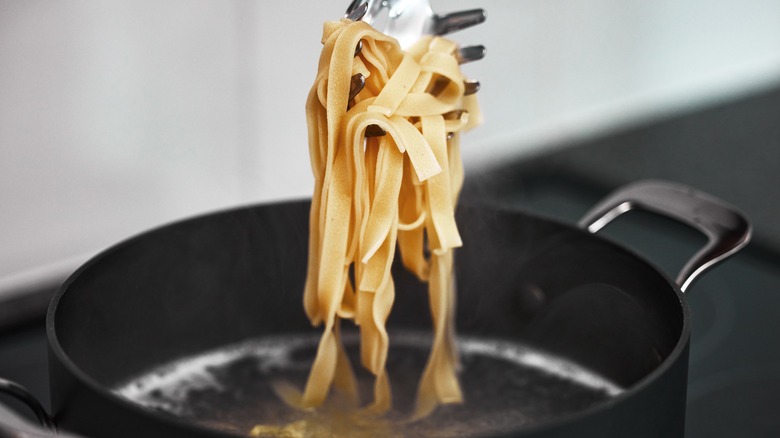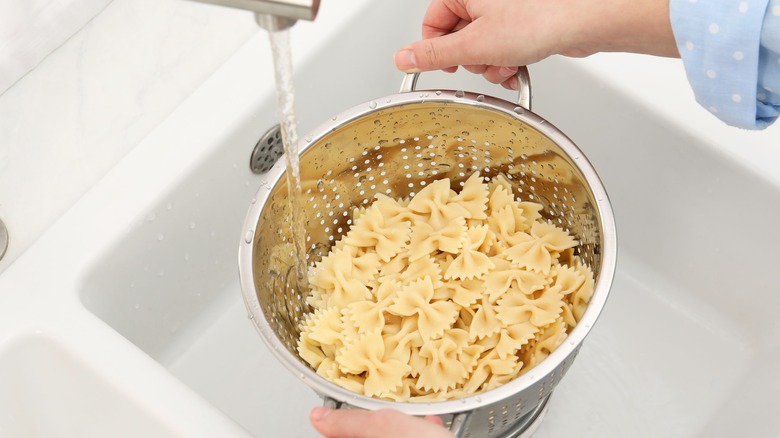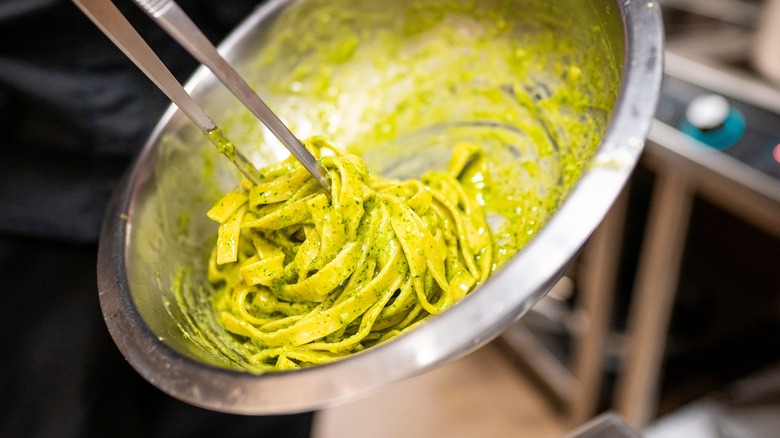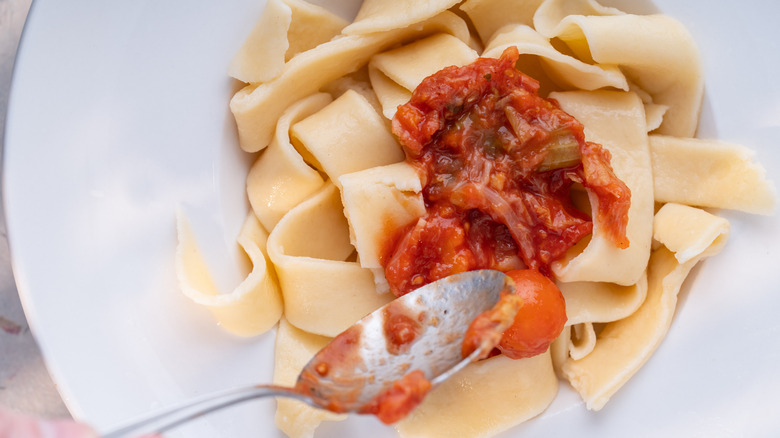22 Mistakes When Making Fresh Pasta, According To The Experts
We may receive a commission on purchases made from links.
Whether it's leftover spaghetti bolognese or mac and cheese, pasta is a comforting plate every single time. It also comes in a range of shapes, sizes and colors: We are spoiled for choice when shopping for the kind we like best. But there's a world of difference between a box of dried pasta and making this delicious food from scratch.
In Italy (and beyond), people have been doing it for years, and online tutorials make it look so easy: But if you've never made fresh pasta before, there are lots of pitfalls. Can you use any flour that's in your store cupboard? Is throwing in more liquid a recipe for disaster? And do you always have to use a fancy machine to create the simplest spaghetti? We turned to Rosario Del Nero, chef and culinary expert with the National Pasta Association, and Jenna Raymond, food scientist at Pappardelle's Pasta for their advice on mistakes to avoid when making fresh pasta.
Assuming experts don't make mistakes
There are hundreds of recipes for making fresh pasta on the internet, and probably twice as many cookbooks, and they all make the process look and sound so simple. After all, it takes a combination of just five ingredients to create the most heavenly form of pasta: flour, eggs, water, oil, and salt. Easy, right?
Not quite. "While pasta making is simple in theory, there is a lot that even experienced chefs can get wrong," said Jenna Raymond. Her biggest pitfalls included over- or under-mixing the pasta dough, adding too much water or not enough, and not resting the dough properly.
Using random flour from your pantry to make fresh pasta
If you're tempted to knock out a batch of pasta using the flour in your store cupboard, it's not the worst idea, but our experts suggested a more thoughtful approach, based on the pasta you want to make. For Rosario Del Nero, it's all a question of taste.
He recommended using all-purpose flours for fettuccine and lasagne. If you want to make your own for spaghetti or linguine, then extra fine durum wheat is better, or you can use durum wheat semolina, though it is harder to use if kneading by hand. "Keep in mind that each kind of flour has slightly different absorption properties," Del Nero said.
Using too many eggs
Anyone who has made pasta by hand has, at some point in the process, been tempted to crack another egg into the mix if it doesn't look like the dough will ever come together. It's not always a good idea, according to our experts. Lots of eggs in your pasta dough risks it becoming sticky and having a gummy texture when cooked.
Your ingredients determine how your pasta dough turns out, from the kind of flour you're using to size of the eggs but the environment can affect it, too. Air humidity and even the kitchen temperature are factors to consider, according to Rosario Del Nero. He insisted: "For two level cups of all-purpose flour usually three eggs are fine."
Only using durum semolina
"Durum semolina is preferred by most chefs because it has a high protein content and creates structurally sound pasta," said Jenna Raymond. Semolina comes from durum wheat, the world's second most-grown wheat and is harder to grind into flour than other grains.
That toughness means some of its starch is lost during the grinding process, so it's not great for baking homemade bread. However, dough made from durum wheat is much stretchier and also retains its shape, making it perfect for pasta. Despite its advantages, home cooks looking to try their hands at making fresh pasta shouldn't feel compelled to use it, according to Rosario Del Nero.
Not using the right flour-to-liquid ratios
Watching Italian nonnas turning a cratered volcano of flour and eggs into the smoothest ball of yellow pasta on the internet might give the impression that any ratio of flour to liquid will have the same outcome. Both our experts gave that assumption a hefty thumbs down.
The balance between these two key ingredients is a delicate one, and not giving it the respect it deserves will lead to a dough that's either too sticky or too dry, resulting in gummy or brittle pasta. Rosario Del Nero said, "It is important to have the correct flour to liquid ratios otherwise the pasta will not be easy to knead, and/or difficult to run through the sheeter."
Not being precise when measuring ingredients for fresh pasta
Home bakers understand that weighing and measuring every ingredient to the exact ounce or gram will give them the best results. It's the same when making fresh pasta. People who have done it for years can probably tell when the dough feels right, adding a dash of flour here or a splash of water there to get the optimum balance.
Newcomers to the process should be as precise as possible and follow established recipes to ensure they get good pasta, according to both our experts. Strict measuring doesn't just apply to commercial manufacturers, per Jenna Raymond, it ensures the required balance of ingredients and gluten development takes place.
Not using a food mixer carefully
If the thought of mixing, rolling and cutting fresh pasta by hand doesn't thrill you, there are lots of machines available that can do the job for you. For example, if you have a KitchenAid, you can use the pasta hook to mix the dough, while this stainless steel attachment will roll and cut the pasta. If you prefer to do it all by hand, a pasta machine like this from Nuvantee makes lighter work of it.
Jenna Raymond advised home cooks making fresh pasta with gadgets not to over-mix the dough and to stick to recipes that have the appropriate instructions. Anyone using an expensive pasta machine that kneads the dough and pushes it through dies should follow the procedures that come with them.
Under-kneading fresh pasta dough
The worlds of bread-making and pasta-making aren't so very far apart, especially when it comes to the process of kneading. For both foods, the dough is pushed, pulled and turned until a rough, sticky ball becomes smooth and elastic, springing back slowly if poked with a finger. It can be hard, physical work, but it's necessary.
Kneading the dough allows the gluten strands within it to properly form, making the pasta pliable enough to be rolled out and cut into the desired form. "Under kneading the dough will not develop the gluten and, therefore, it will not have the right consistency; it will not be elastic, it could be brittle," said Rosario Del Nero.
Coloring fresh pasta with the wrong ingredients
Pasta sauce can be a sneaky way of getting vegetables into children but fresh pasta can be a great way to introduce them too, not to mention adding a splash of color to their plate. Jenna Raymond recommends adding spinach, carrot, and beet flours to pasta dough, but they're not the only method available to home cooks.
Pureed fresh spinach makes great green pasta, while finely chopped herbs will give a speckled look, as well as a flavor boost, and pureed red beets turn pasta a vibrant purple. Rosario Del Nero added, "Just remember that the vegetable purées will partially take the place of the volume of the beaten eggs. If using spinach, steam first, and then squeeze dry to avoid excess liquid."
Not resting fresh pasta dough
Every carnivore knows that resting leads to the juiciest steaks, but meat isn't the only food that benefits from a little time out. After you've mixed and kneaded your pasta dough, achieving that smooth ball that's tacky but not sticky, it's wise to set it aside. It should rest for anywhere between half an hour at room temperature or overnight in the fridge, depending on when you want to use it.
It's a crucial step that should not be skipped, as it gives the flour enough time to evenly and fully absorb all the moisture of the eggs, according to Rosario Del Nero. "Resting the dough allows the gluten to relax and makes the dough easy to work with," said Jenna Raymond.
Panicking if dough is too sticky or too dry
We've all been there: Peeling sticky clumps of flour from our fingers, or trying to bring together a stubbornly dry mess on the table, while the online tutorial we're following has produced a perfect ball of pasta dough. What's a stress-out home cook to do? The first thing to do is not to panic. The second, according to our experts, is to fine-tune your pasta dough.
If your dough is too sticky, the likely culprit will be the eggs, oil, or water. Either way, adding a dash of flour can restore the balance. Likewise, if your dough refuses to come together, a little water or oil will help. "It is important to follow the recipe very carefully to avoid these mistakes," said Jenna Raymond.
Hand rolling fresh pasta unevenly
Not everyone has access to fancy kitchen gadgets that will roll out and cut their fresh pasta for them, and both our experts agreed that there was nothing wrong with sticking to the tried-and-tested rolling pin. If you need a longer one than the standard pastry kind, this beechwood one from Fulimax is great for pizza dough, too.
It might take a lot of practice to make sure your fresh pasta stays thin enough to be palatable, but it's definitely achievable. Jenna Raymond advised home cooks to, "Follow the instructions to ensure the dough is an equal height so it cooks evenly."
Not laminating fresh pasta
When making flaky or blitz pastry, it's important to roll out, turn, and fold the dough over several times to get lots of little layers of butter and dough. When cooked, the butter melts and the dough puffs up — known as lamination. A similar process is needed for fresh pasta but there's a very different reason behind it.
"Laminating fresh pasta is important because it strengthens the gluten network," said Jenna Raymond. The process of running the fresh pasta dough through a machine over and over strengthens the sheets, making them less likely to break when rolled very thin or cut into shapes.
Not washing the pasta machine
The humble rolling pin has many uses, including making fresh pasta, and makes cleaning up quick and easy. Anyone using a pasta machine should keep it spotless to prevent bacterial growth — nobody wants to eat that kind of green pasta.
Cleaning them after every use eliminates that possibility, and will keep them in working order for years. Rosario Del Nero advised owners of pasta machines to closely read the manufacturer's instructions, and warned: "For most machines — never get them wet. Use forced air or a dry brush."
Not salting the cooking water
To salt or not to salt: That is the question, unless you're using an unconventional way to cook your pasta. Adding salt to cooking water does two things: It raises the boiling point, so it takes a few seconds longer to get to that stage. It also reduces the specific heat capacity, which is the amount of heat needed to raise the temperature by one degree.
Most cooks add about 3 grams of salt to their water, but not to influence the water's temperature. Both our experts agreed salting the water can add a little extra flavor to the dough. "As the pasta cooks, it will absorb the lightly salted water," said Rosario Del Nero.
Adding oil to the cooking water
The debate about whether home cooks should add a little oil to their water before cooking fresh or dried pasta has raged for decades. Those in favor of the move say a dash of olive oil prevents the pasta from clumping together in the pan, can prevent the water from boiling over and may even add nutrients to the cooked pasta.
For our experts, it is a no-no. "Properly made pasta should not stick together while being cooked, and should be stirred to further prevent this," said Jenna Raymond. Rosario Del Nero added, "Adding oil to cooked and drained pasta will prevent the pasta from being able to properly absorb the sauce."
Putting fresh pasta in before the water has boiled
Many professional chefs and industry experts are generous with their advice for home cooks, but in kitchens across the country, some of us are making mistakes with fresh pasta that would have the experts' hair standing on end. One of them is dropping our home-made linguine, spaghetti or ravioli into a pan of stone cold water.
Some people think the pasta will start to cook as the water warms, speeding up the process but in fact, the opposite happens. It could also ruin all your hard work, as your pasta could end up with a gummy texture, warned Jenna Raymond. For the best results, wait until the water is boiling.
Not stirring fresh pasta when it first goes into the pan
Many people put their fresh pasta into boiling water and leave it, wondering why they end up with a large lump of pasta in their pan. Paying a little bit of extra attention at the start of the cooking process will reap its own rewards, but you don't have to be heavy handed with the wooden spoon.
"Fresh pasta is very delicate and you need to gently stir it so it does not stick together while cooking," said Rosario Del Nero. A quick swirl in the water will also ensure your fresh pasta cooks evenly, too.
Overcooking or undercooking fresh pasta
Checking if your fresh pasta is cooked to perfection is tricky. The term 'al dente' is Italian for "to the tooth." In pasta terms, it feels firm but still chewy when bitten. "Overcooking can make the pasta too gummy and undercooking can make the pasta too rigid or brittle," said Jenna Raymond.
Rosario Del Nero warned that fresh pasta usually cooks in a couple of minutes. He recommended watching for when it started to float in the water then take out a piece and bite it. To go beyond al dente, only give it one minute longer to cook.
Rinsing fresh pasta after cooking
Who would have thought the simple act of running cooked fresh pasta under water would be so controversial? Millions of home cooks rinse their pasta, to the frustration of professionals, including our experts. "Some gluten-free pasta requires rinsing but this is not the case for gluten-containing pasta," said Jenna Raymond.
Rosario Del Nero was adamant: "Do not rinse fresh pasta," he said, adding: "Just drain it and add it to your sauce or toss it in a pan or a bowl with sauce." Del Nero recommended pairing fresh pasta with good quality, real olive oil or butter, and a simple grating of authentic Parmigiano Reggiano.
Forgetting fresh pasta continues to cook in a sauce
Cooking is, in many ways, a science, and understanding how ingredients work can help us get the best out of them. One of the reasons that fresh pasta is cooked "al dente," so there's still a little structure to it, is because of a phenomenon known as carry over cooking.
Most food is cooked from the outside in, and even when it is removed from the oven or pan, the heat energy is still driven toward the center of an ingredient. Think of a piece of roast meat that is set aside to rest. A similar phenomenon happens with fresh pasta, when it is mixed with a sauce: The heat from the latter provides a fresh cooking boost.
Pairing fresh pasta with an unsuitable sauce
Many of us think that most forms of pasta can be served with any kind of sauce, but for Jenna Raymond, it's a mistake. "Traditionally hollow pastas, like penne or rigatoni, are best served with thick chunky sauces," she said, while twisted shapes, such as fusilli or cavatappi, need finer ones.
She recommended cream sauces for linguine or trenette, and something more substantial for thick flat pastas, like pappardelle. The advice from Rosario Del Nero? "Keep it simple, then experiment with caution."
